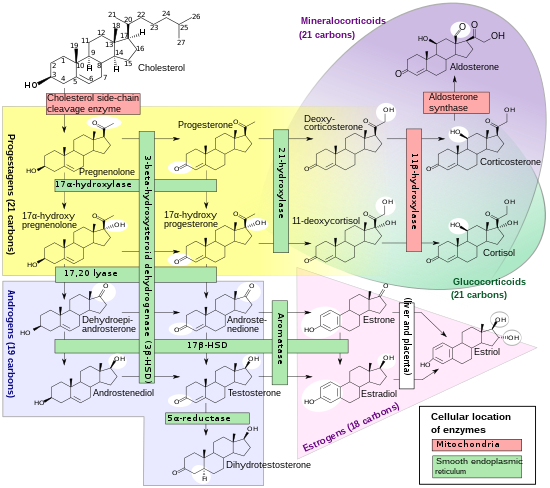User:Tony Mach/Steroidogenesis
Steroidogenesis[edit]
Steroidogenesis is the biological process by which steroids are generated from cholesterol and transformed into other steroids.[1] The pathways of steroidogenesis differ between different species – as an example the pathways of human steroidogenesis are shown in this figure below.
Human steroidogenesis[edit]

The major classes of steroid hormones and some prominent human steroid hormones are:
The following text exemplifies the human steroidogenesis, as the steroidogenesis differs between species.
The synthesis of steroids
adrenocorticotropic hormone (ACTH, also known as corticotropin)
hypothalamic–pituitary–adrenal axis
The rate-limiting step of steroid synthesis is the conversion of cholesterol to pregnenolone, which occurs inside the mitochondrion.[2]
Corticosteroids are produced in the adrenal glands.
Estrogen, progesterone and testosterone are primarly produced in the human gonads. Testosterone is also converted into estrogen to regulate the supply of each, in the bodies of both females and males.
Estrogen and progesterone are made primarily in the ovary and in the placenta during pregnancy,
Testosterone is synthesized in the testes.
Certain neurons and glia in the central nervous system (CNS) express the enzymes that are required for the local synthesis of pregnane neurosteroids, either de novo or from peripherally-derived sources.
Stuff[edit]
- ^ Hanukoglu I (Dec 1992). "Steroidogenic enzymes: structure, function, and role in regulation of steroid hormone biosynthesis". J Steroid Biochem Mol Biol. 43 (8): 779–804. doi:10.1016/0960-0760(92)90307-5. PMID 22217824.
{{cite journal}}: CS1 maint: date and year (link) - ^ Rossier MF (2006). "T channels and steroid biosynthesis: in search of a link with mitochondria". Cell Calcium. 40 (2): 155–64. doi:10.1016/j.ceca.2006.04.020. PMID 16759697.

